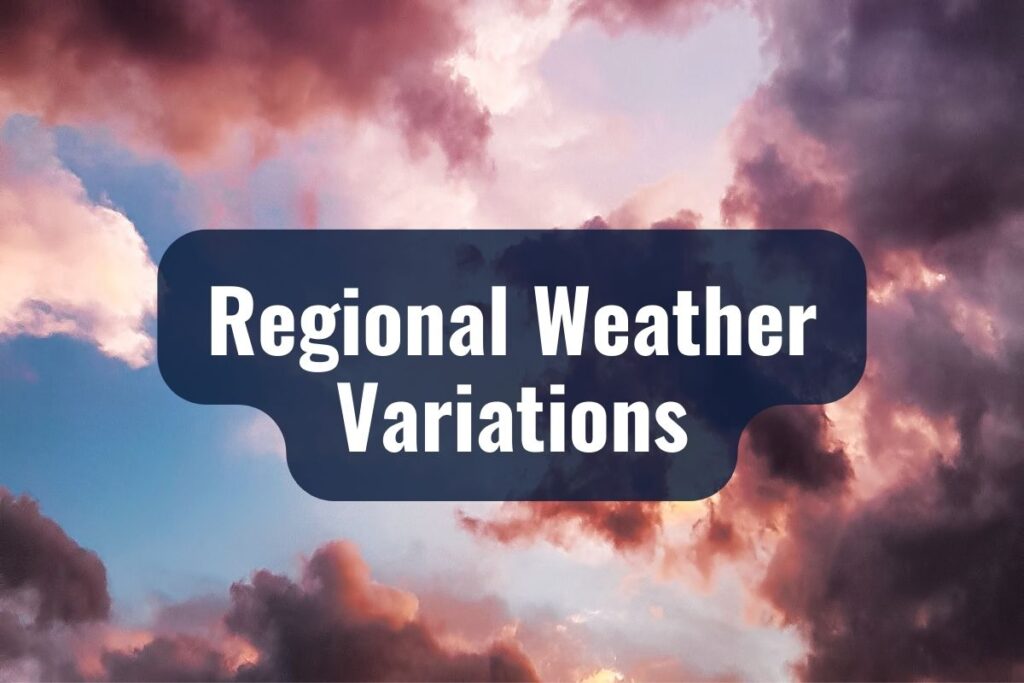France enjoys a reputation for its beautiful and varied landscapes, which bring with them a diversity of climate patterns. For foreigners planning to visit or reside in France, grasping these weather nuances can significantly enhance the experience, especially in the summer month of June.
Stay tuned as we delve deeper into regional variations, temperature norms, and tips for adapting to the June weather in France. Whether you’re in France for work, leisure, or daily life, knowing what to expect from the skies will keep you one step ahead.
KEY TAKEAWAYS
- Diverse Climates: France’s weather in June varies widely from north to south and east to west.
- Temperature Ranges: Prepare for average highs of 20°C to 25°C in the north and up to 28°C in the south.
- Rain and Humidity: Expect variable rainfall and prepare for sudden showers, especially in the north and west.
- Long Days: Enjoy up to 16 hours of daylight around the summer solstice in June.
- Preparation is Key: Layer clothing, stay updated on forecasts, and adapt plans according to regional weather.
- Seek Local Insights: Utilize local knowledge and resources for the most accurate weather information.
The Importance of June Weather
June marks the transition into the full swing of summer, bringing longer days and generally warmer temperatures. However, the weather can vary significantly from the northern coasts to the southern Riviera and from the western Atlantic fronts to the eastern borders.
Understanding these patterns is crucial for planning everything from daily outings and wardrobe choices to travel itineraries. For newcomers, especially those unaccustomed to European or Mediterranean climates, this knowledge can make the transition smoother and the stay more enjoyable.
Regional Weather Variations

Understanding the regional weather variations in France is key to navigating and enjoying your time in the country, especially in June, when the summer is beginning to peak. Here’s what you need to know about the weather in different parts of France during this month.
| Region | Climate Type | Average High (°C) | Average Low (°C) | Notable Weather |
| North France (e.g., Paris) | Mild temperate | 20 – 25 | 12 – 15 | Variable, with occasional showers |
| South France (e.g., Nice) | Mediterranean | 24 – 28 | 16 – 20 | Warm and sunny with minimal rain |
| East & West France | Atlantic/Continental | 17 – 30 | 10 – 20 | Mild in west, warmer and variable in east |
North France: Channel Coasts and Inland
Channel Coasts
The northern coast of France, including places like Normandy and Brittany, experiences a maritime climate. June brings milder temperatures, with averages of around 15°C to 20°C (59°F to 68°F).
However, the weather can be unpredictable, with a mix of sunny spells and rainy days. The coastal breeze can also make it feel cooler, so carrying a light jacket or a windbreaker is advisable.
Inland Areas
Moving inland, the temperatures may be slightly warmer, but this region still retains a lot of the coastal climate’s characteristics: a fair amount of rain and variability day-to-day. Cities like Paris experience an average high of 20°C to 25°C (68°F to 77°F) in June, with occasional heatwaves pushing temperatures higher.
South France: Mediterranean Influence
Mediterranean Coast
The French Riviera and other parts of the southern coast boast a Mediterranean climate, characterized by warmer temperatures and more stable weather. In June, cities like Nice and Marseille see temperatures ranging from 20°C to 27°C (68°F to 80°F), with plenty of sunshine and low rainfall. This is ideal weather for enjoying the beaches and outdoor activities.
Inland South
Further inland, the temperatures are warm but can be more variable. The warmth can intensify in areas away from the sea, making afternoons particularly hot. However, the evenings tend to be cooler and more pleasant.
East and West France: Atlantic and Continental Climates
Western Atlantic Coast
The west coast, influenced by the Atlantic Ocean, has a temperate climate with mild temperatures in June, usually ranging between 17°C to 22°C (63°F to 72°F).
The weather can be quite changeable with a mix of sunny days and rainy periods. Coastal towns like Bordeaux enjoy more sunshine but are also subject to sudden weather shifts.
Eastern France: Continental Influence
Eastern France, closer to Germany and Switzerland, experiences a continental climate with warmer summers. In June, areas like Alsace and Lorraine see temperatures similar to Paris but with less humidity and more stable weather patterns. The days are warm, but mornings and evenings can be cool, especially in mountainous areas.
Temperature Ranges
Navigating through France in June means acquainting yourself with the typical temperature ranges across different regions. This knowledge is vital for planning your daily activities, choosing the right clothing, and understanding what each part of France offers weather-wise during this early summer month.
Average Temperature Highs and Lows
In June, France begins to warmly welcome the summer season. The temperature varies significantly across the country, influenced by regional climates.
Northern France: In cities like Paris and Lille, average highs are typically around 20°C to 25°C (68°F to 77°F), with lows in the early morning and late night around 12°C to 15°C (54°F to 59°F).
Southern France: The south experiences warmer temperatures, with daytime highs often reaching 24°C to 28°C (75°F to 82°F), especially along the Mediterranean coast. Nighttime lows are milder, staying around 16°C to 20°C (61°F to 68°F).
Eastern and Western France: The east, with its continental climate, can have higher peaks during heat waves, with temperatures occasionally reaching above 30°C (86°F). The west, influenced by the Atlantic, sees milder temperatures ranging from 17°C to 22°C (63°F to 72°F).
Regional Variations
The temperature in June can vary significantly not just from north to south but also from day to day within the same region due to France’s diverse geography and climatic influences. Here’s how it breaks down:
Mountain Areas
In places like the Alps or Pyrenees, temperatures can be considerably cooler, especially at higher altitudes. Even in June, it’s not uncommon for mountainous areas to experience a sudden drop in temperature, reminding visitors of the lingering spring or early autumn.
Coastal Regions
Coastal areas, particularly along the Mediterranean, enjoy a more temperate climate with the sea breeze moderating the heat, making for pleasant, warm days and cooler, comfortable evenings.
Urban Areas
Large cities, especially Paris, can feel warmer due to the urban heat island effect. Concrete and asphalt store heat during the day and release it at night, leading to warmer evenings and nights compared to rural areas.
Precipitation and Humidity

June in France brings not just warmth but also varying levels of precipitation and humidity, affecting everything from the lushness of the landscape to the comfort of daily activities. Understanding these aspects can significantly impact your experience, allowing for better planning and preparation.
Average Rainfall in June
The amount of rainfall in June can vary greatly depending on the region:
Northern France: Areas like Normandy and Paris can experience moderate rainfall, with an average of 50 to 60 mm spread over the month. Rain typically comes in short, heavy bursts, interspersed with sunny periods.
Southern France: The Mediterranean climate of the south leads to drier conditions. Cities like Marseille and Nice might see lower averages of around 20 to 30 mm of rain, mostly in the form of quick showers, if at all.
Western and Eastern France: The west coast is influenced by the Atlantic, and the east, with more continental weather patterns, sees varied rainfall. The west might have more consistent but lighter rain, whereas the east may have occasional storms, especially in the late afternoon.
Humidity Levels
Humidity can significantly affect how the actual temperatures feel. Here’s how humidity generally behaves in France during June:
Coastal Areas
Coastal regions, especially in the north and west, can feel quite humid, with moisture coming in from the sea. This can make the air feel cooler or stickier, depending on the temperature.
Inland and Urban Areas
Cities and inland regions may experience less humidity, particularly in the south and east. However, urban areas can feel more oppressive during heatwaves when the humidity combines with high temperatures and a lack of wind.
Stay Informed
Keep an eye on the local weather forecasts, especially if you plan to travel around the country or engage in outdoor activities.
Appropriate Clothing
Light, breathable clothing is typically suitable for June’s weather. However, always carry an umbrella or a light waterproof jacket for unexpected showers, especially in the north and west.
Plan Around Midday
In areas with high heat and humidity, try to avoid outdoor activities during the hottest part of the day, usually from noon to 3 p.m.
Stay Hydrated
Higher temperatures and humidity can lead to quicker dehydration, so carry water with you and drink regularly.
Sunlight and Day Length
June is a month of long days and abundant sunlight in France, as it marks the approach of the summer solstice, the longest day of the year. This increase in daylight has a profound effect on daily life, activities, and the general mood of the country.
Average Hours of Daylight
As June progresses, the days lengthen, peaking at the summer solstice around June 21st. Here’s what you can expect in terms of daylight:
Northern France: Areas in the north, including Paris, enjoy long days with up to 16 hours of daylight around the solstice. Sunrise can be as early as 5:30 AM, with sunset stretching out past 10:00 PM.
Southern France: The south also benefits from lengthy days, though slightly shorter than the north, with daylight lasting about 15 hours during the peak of June. The Mediterranean coast sees the sun rising around 6:00 AM and setting around 9:00 PM.
Eastern and Western France: Similar patterns of extended daylight are observed across the country, with slight variations due to geographic location and topography.
Impact on Lifestyle and Activities
The increase in daylight hours has several implications:
Outdoor Activities
Longer days mean more time for outdoor activities. Whether it’s sightseeing, hiking, or enjoying the many festivals and events that take place in June, the extended daylight allows for fuller days.
Cultural and Social Life
Evenings are longer and warmer, encouraging people to enjoy outdoor dining, socializing, and cultural events well into the night.
Health and Wellbeing
The abundance of sunlight can boost mood and vitamin D levels, contributing to a general sense of well-being among residents and visitors alike.
Planning for the Extended Daylight
Sun Protection: With more hours of sunlight, it’s important to protect against sunburn and heat exhaustion, especially in the middle of the day when the sun is strongest.
Maximizing Daytime: Plan activities to take advantage of the extended daylight, perhaps visiting attractions earlier or later in the day to avoid the busiest times.
Enjoying the Evenings: Consider participating in local evening events or simply enjoying a leisurely meal outdoors to experience the vibrant nightlife that the long days of June bring.
Advice for Foreigners

Navigating through the diverse weather of France in June can be much smoother with a few practical tips. Here’s how you can make the most of your time, whether you’re visiting for a short while or settling in for a longer stay.
Clothing and Accessories
Layered Clothing: Opt for layers that you can add or remove as the day progresses. Mornings might be cool, afternoons warm, and evenings chilly, especially in certain regions or near the coast.
Sun Protection: A hat, sunglasses, and sunscreen are essential to protect against the strong sun, particularly in the south or during unusually hot spells.
Rain Gear: A compact umbrella or a light waterproof jacket should be a staple in your bag, as June can still bring unexpected showers, particularly in the north and west of France.
Comfort and Health
Stay Hydrated: Carry a water bottle with you, especially when out sightseeing or participating in outdoor activities. June can have some particularly hot days, and staying hydrated is key.
Seek Shade: During peak sun hours, usually between 11 a.m. and 3 p.m., try to stay out of direct sunlight or take frequent breaks in the shade.
Acclimatize: Give your body time to adjust to the temperature changes, especially if you’re not used to the climate in France. Avoid strenuous activities during the hottest parts of the day.
Check Forecasts Regularly: Weather can change quickly, especially in regions with variable climates. Stay updated with local forecasts to plan your day accordingly.
Understand Regional Climates: Familiarize yourself with the typical weather patterns of the region you’re visiting. What’s true for Paris might not be the same in Nice or Strasbourg.
Cultural Enjoyment
Participate in Local Events: June is a vibrant month in France, with many cultural festivals and events taking place. These are often outdoors, taking advantage of the pleasant weather.
Enjoy Outdoor Dining: Many restaurants and cafes have outdoor seating areas; enjoy the long evenings and mild nights by dining al fresco.
Language and Communication
Learn Key Phrases: Knowing how to ask about the weather or understanding forecasts in French can be very helpful. Even learning basic phrases can improve your experience interacting with locals.
Use Technology: Various apps and websites offer up-to-date weather forecasts in English, making it easier to plan your day or week.
Understanding Weather Forecasts
For foreigners in France, particularly those not familiar with the language or local weather patterns, understanding how to access and interpret weather forecasts is crucial. Here’s how you can stay ahead of the weather and make informed decisions about your daily plans in June.
Resources for Accurate Weather Forecasts
Local News and Radio
These are great for daily updates, often providing detailed information about the weather in different parts of the country.
Weather Websites and Apps
Many reliable websites and apps offer forecasts in multiple languages, including English. Look for those that provide regional forecasts for the most accurate information.
Tourist Information Centers
Staff can often provide weather information or guide you to the best resources, especially in regions with variable climates or outdoor activities.
Tips on Interpreting Weather Forecasts
Understanding Terms: Familiarize yourself with basic meteorological terms in English and possibly their French equivalents, such as “precipitation,” “humidity,” “highs/lows,” and “UV index.”
Regional Differences: Be aware of how the weather can change between regions. A forecast for Paris will not apply to Marseille or Lyon. Look for forecasts specific to your area.
Time of Day: Pay attention to how the weather might change throughout the day. Morning forecasts might differ significantly from afternoon or evening predictions, especially in terms of temperature and precipitation.
Planning Accordingly
Flexible Plans: Allow for some flexibility in your plans, especially if you intend to engage in outdoor activities. Be ready to adjust based on the latest weather forecasts.
Safety First: Always prioritize safety, especially when planning activities that might be affected by severe weather, such as hiking in the mountains or visiting coastal areas.
Cultural Insights: Sometimes, locals have a good sense of typical weather patterns and can offer advice or insights. Engaging with local communities can provide valuable on-the-ground weather wisdom.
Potential Weather Challenges

While June in France is predominantly marked by pleasant weather, it’s not without its potential challenges. Being aware of these and knowing how to navigate them can make all the difference in enjoying a comfortable and safe visit.
Common Weather-Related Challenges
Heatwaves
Especially in the south and occasionally in other parts of the country, June can experience periods of intense heat. This can lead to discomfort, dehydration, or heat-related illnesses, particularly for those not used to high temperatures.
Sudden Showers
June can still bring unexpected rain, particularly in the north and west. These sudden showers can disrupt travel plans or outdoor activities if not prepared.
Variable Temperatures
Even within a single day, temperatures can vary significantly, especially when traveling between regions or going from coastal to inland areas. This variability can make it challenging to dress appropriately or plan activities without considering the local weather.
Region-Specific Advice
Northern France: Be prepared for changeable weather. Carry a lightweight, waterproof jacket and an umbrella.
Southern France: Stay hydrated and wear light, breathable clothing to combat the heat. Always have sun protection, such as sunscreen, hats, and sunglasses.
Eastern and Western France: Keep an eye on the forecast for sudden temperature changes or storms, particularly if you’re planning to explore the countryside or engage in outdoor activities.
Preparing for Unexpected Conditions
Stay Informed: Regularly check the weather forecast for updates, especially if you have specific plans or are traveling to different parts of the country.
Emergency Kit: Have a small emergency kit with essentials like water, snacks, basic first aid, and any necessary medications.
Local Knowledge: Don’t hesitate to ask locals for advice. They can provide insights into typical weather patterns and how to best deal with unexpected changes.
Closing
As June unfolds in France, the country blossoms with long days, diverse cultural events, and the vibrant life that summer brings. Understanding the weather is key to making the most of your time here, whether you’re soaking in the sun on the southern coast, exploring historic cities, or enjoying the lush countryside.
Embracing June’s Weather
June’s weather, with its longer days and warmer temperatures, provides an ideal backdrop for a wide range of activities. From outdoor cafes and scenic walks to festivals and cultural events, there’s something for everyone to enjoy.
By staying informed and prepared, you can navigate the weather with ease and confidence, making your stay both enjoyable and memorable.
Staying Informed and Prepared
The weather can vary greatly across different regions of France, so always check the local forecast and plan accordingly. Dress in layers, stay hydrated and carry essentials like sun protection and a raincoat or umbrella. With a little preparation, you’ll be well-equipped to handle whatever weather June has in store.
A Final Note of Encouragement
We hope this guide has provided valuable insights into navigating France’s weather in June. With this knowledge, you’re ready to embrace the beauty and diversity of France’s early summer.
So go ahead, step out, and enjoy all the delights that this month has to offer, from the sunny Mediterranean shores to the charming streets of Paris and beyond. Bon voyage!


